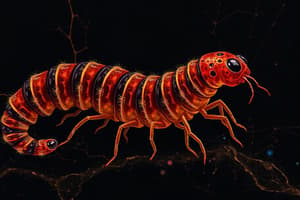Podcast
Questions and Answers
John Sulston's research primarily focused on which model organism, and what key characteristic makes it ideal for his studies?
John Sulston's research primarily focused on which model organism, and what key characteristic makes it ideal for his studies?
- Escherichia coli, its simple cellular structure
- Saccharomyces cerevisiae, its ease of genetic manipulation
- Caenorhabditis elegans, its precisely defined number of cells (correct)
- Drosophila melanogaster, its rapid life cycle
Sulston's contribution to the field of genomics is best described as:
Sulston's contribution to the field of genomics is best described as:
- Discovering the structure of DNA
- Developing the polymerase chain reaction (PCR) technique
- Pioneering the sequencing of a complete animal genome, contributing to the Human Genome Project (correct)
- Leading the first complete sequencing of a plant genome
What scientific milestone did John Sulston achieve that earned him a Nobel Prize?
What scientific milestone did John Sulston achieve that earned him a Nobel Prize?
- Elucidation of programmed cell death mechanisms (correct)
- Development of gene editing technology
- Development of DNA sequencing technology
- Discovery of the structure of DNA
In what year did Sulston's work contribute to the first complete sequencing of an animal genome?
In what year did Sulston's work contribute to the first complete sequencing of an animal genome?
What was John Sulston's role at the Wellcome Sanger Institute?
What was John Sulston's role at the Wellcome Sanger Institute?
Flashcards
John Sulston
John Sulston
An English biologist known for his work in genome research.
Nobel Prize 2002
Nobel Prize 2002
Award shared by Sulston for research on programmed cell death.
C. elegans
C. elegans
A small nematode worm used for studying cell processes.
Genome Sequencing
Genome Sequencing
Signup and view all the flashcards
Human Genome Project
Human Genome Project
Signup and view all the flashcards
Study Notes
John Sulston
- English biologist, director of the Wellcome Sanger Institute
- Shared the 2002 Nobel Prize for work on programmed cell death
- Focused his research on the nematode worm Caenorhabditis elegans
- This worm has a specific number of cells, making it ideal for studying cell differentiation, division, and programmed cell death
- His work contributed to the sequencing of the first animal genome (C.elegans) in 1988
- His research was key to the Human Genome Project (1990-2003)
Studying That Suits You
Use AI to generate personalized quizzes and flashcards to suit your learning preferences.




